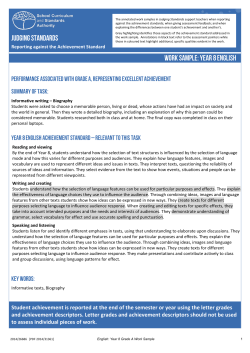
Judging Standards Work Sample: PRE-PRIMARY - K
The annotated work samples in Judging Standards support teachers when reporting against the achievement standards, when giving assessment feedback and when explaining the differences between one student’s achievement and another’s. Grey highlighting identifies those aspects of the achievement standard addressed in the work sample. Annotations in black text refer to the assessment pointers, while those in coloured text highlight additional, specific qualities evident in the work. Reporting against the Achievement Standard Informative writing: Recount – My news Once a week, the children participated in an oral and written recount session. The class sat in a ‘sharing circle’; each child told their news. The children participated in a modelled writing session led by the teacher who wrote her news. The children wrote their news with the sentence starter, ‘On the weekend,’ written on the board. For this task, the children told their news to the group and then wrote. The sentence starter was not used. No assistance was given. Classroom environmental print was available. After completing their writing, the children shared their work with the teacher. Reading and viewing By the end of the Pre-primary year, children use predicting and questioning strategies to make meaning from texts. They recall one or two events from texts with familiar topics. They understand that there are different types of texts and that these can have similar characteristics. They identify connections between texts and their personal experience. They read short, predictable texts with familiar vocabulary and supportive images, drawing on their developing knowledge of concepts about print and sounds and letters. They identify the letters of the English alphabet and use the sounds represented by most letters. Writing and creating When writing, children use familiar words and phrases and images to convey ideas. Their writing shows evidence of sound and letter knowledge, beginning writing behaviours and experimentation with capital letters and full stops. They correctly form known upper- and lower-case letters. Speaking and listening They listen to and use appropriate language features to respond to others in a familiar environment. They listen for rhyme, letter patterns and sounds in words. Children understand that their texts can reflect their own experiences. They identify and describe likes and dislikes about familiar texts, objects, characters and events. In informal group and whole class settings, children communicate clearly. They retell events and experiences with peers and known adults. They identify and use rhyme, letter patterns and sounds in words. Creating texts, Informative texts, Factual recounts Student achievement is reported at the end of the semester or year using achievement descriptors. Achievement descriptors should not be used to assess individual pieces of work. 2014/2406 [PDF 2014/4612] English: Pre-primary High Achievement Work Sample 1 Creates a detailed drawing that relates to the writing. Creates short texts with related sentences to record ideas and events using familiar words, phrases, images and beginning writing knowledge, with an accompanying drawing if required. Some events and ideas are sequenced. Writes detailed simple sentences, reflecting oral language patterns to convey ideas, events and/or information. Writes familiar words and phrases which add detail and uses illustrations to convey meaning related to personal experience or a specific topic, e.g. ‘the swerl slid’ (the swirl slide), ‘the srat slid’ (the straight slide). Correctly spells some highfrequency words, including ‘and’, ‘the’ and simple CVC words, e.g. ‘On’, ‘fun’. Spells words phonetically, representing most sounds, e.g. Bech (beach), ‘slid’ (slide) ‘swerl’ (swirl), ‘srat’ (straight). Uses capital letters to begin sentences and uses a full stop to mark the end of a sentence. Correctly forms known uppercase and lower-case letters using appropriate starting point, with developing uniformity. 2014/2406 English: Pre-primary High Achievement Work Sample 2
© Copyright 2025





















